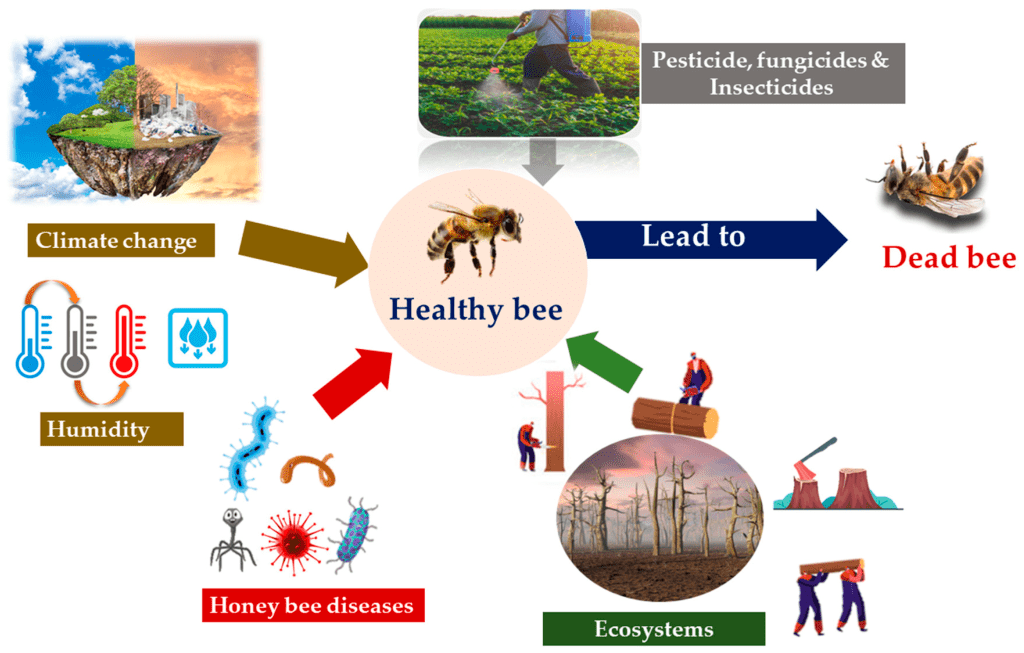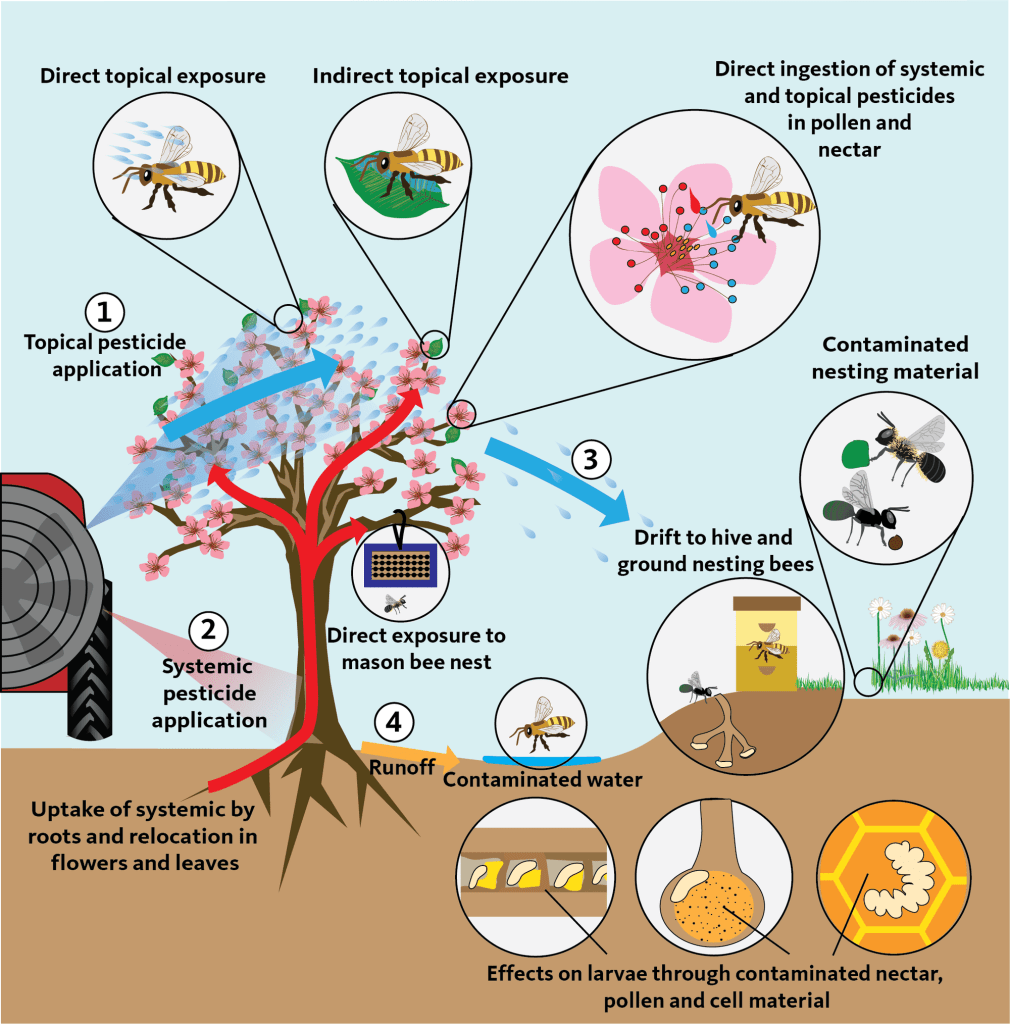
Table of Contents
- Introduction
- Understanding Pollinators and Their Role in Agriculture
- The Importance of Pollinators in Crop Production
- Challenges Facing Pollinators
- Practical Steps to Protect Pollinators on Your Farm
- The Economic Impact of Pollinators
- Conclusion
- References
Introduction
Farming is not just about planting and harvesting, it’s about understanding the delicate balance of nature that makes food production possible. Among the unsung heroes of agriculture are pollinators, especially bees, whose work significantly enhances crop yields and quality.

In Nigeria, where agriculture contributes about 25% of the GDP, ensuring pollinator health is an economic necessity. Yet, pollinators face increasing threats from habitat destruction, pesticide misuse, and climate change. In this blog we will explore the critical role of pollinators in agriculture, the challenges they face, and practical steps farmers can take to protect these essential creatures while boosting yields.
Understanding Pollinators and Their Role in Agriculture
What Are Pollinators?
Pollinators are animals that transfer pollen from one flower to another, facilitating plant fertilization and seed production. Without pollination, many crops wouldn’t produce fruit or viable seeds.
Key Pollinators in Agriculture
Bees: The most effective pollinators, responsible for pollinating over 70% of crops globally.
Butterflies and Moths: Assist with pollinating fruits, vegetables, and flowers.
Birds (e.g., Hummingbirds): Play a role in pollinating tropical crops like bananas and plantains.
Beetles and Flies: Contribute to pollinating crops like cocoa and palm oil.

The Importance of Pollinators in Crop Production
Increased Crop Yields
Crops like cucumbers, tomatoes, cashews, and cocoa heavily depend on pollinators. Farms with healthy pollinator activity experience 30%–40% higher yields compared to farms without pollinators.
Improved Crop Quality
Pollination enhances fruit shape, size, and shelf life. For instance, bee-pollinated melons are sweeter and larger, while poorly pollinated crops are more likely to deform or fail to mature.
Biodiversity and Ecosystem Balance
Pollinators are essential for maintaining biodiversity. They support wild plant growth, which in turn provides shelter and food for other animals, strengthening the ecosystem on and around your farm.
Challenges Facing Pollinators
Habitat Loss
The expansion of monoculture farming and urbanization destroys pollinators’ natural habitats, reducing their food sources and nesting areas.
Pesticide Use
While pesticides control pests, indiscriminate pesticide use can kill or weaken pollinators. Neonicotinoids are particularly harmful, affecting bees’ navigation and reproduction.

Climate Change
Extreme weather events and temperature shifts disrupt the timing between flower blooming and pollinator activity, reducing pollination efficiency.
Diseases and Parasites
Pathogens like the Varroa mite weaken bee populations, while poor colony health reduces their ability to pollinate crops effectively.
Practical Steps to Protect Pollinators on Your Farm

Pollinators, particularly bees, play a crucial role in agricultural productivity and food security. Protecting and supporting these vital species is essential for sustaining high crop yields and preserving biodiversity. Farmers can take several practical measures to create an environment where pollinators thrive. These steps include implementing pollinator-friendly farming practices, reducing harmful chemical use, creating and preserving habitats, and supporting native pollinators. Each of these approaches contributes to safeguarding pollinators while enhancing agricultural sustainability.
Implementing Pollinator-Friendly Farming Practices
One of the most effective ways to protect pollinators is by adopting pollinator-friendly farming practices. This begins with planting flowering cover crops, such as clover, alfalfa, and wildflowers, which provide food and shelter for pollinators during non-growing seasons. These cover crops not only sustain pollinators but also improve soil quality, prevent erosion, and promote better water retention.
Additionally, crop rotation is a simple yet powerful practice that benefits both pollinators and the farm ecosystem. By alternating crops each season, farmers can maintain healthy soil, reduce pest infestations, and ensure a continuous supply of diverse floral resources for pollinators. For example, rotating between legumes and cereals can create a balanced environment where both crops and pollinators can thrive. Such practices support biodiversity and increase the resilience of the agricultural landscape.
Moreover, reducing monoculture (the practice of growing a single crop repeatedly) is essential. Monoculture fields lack the floral diversity required to sustain pollinators year-round. Integrating intercropping where different crops are grown together can significantly increase floral variety, which in turn provides pollinators with better foraging opportunities. Implementing these pollinator-friendly practices fosters a healthier and more productive farming system.
Reducing Harmful Chemical Use
The use of pesticides, herbicides, and fungicides is a common practice in modern agriculture, but these chemicals pose significant risks to pollinators. Exposure to toxic chemicals can impair pollinators’ ability to navigate, forage, and reproduce. To protect pollinators, farmers can adopt Integrated Pest Management (IPM) strategies, which aim to control pests while minimizing harm to beneficial species.
IPM involves using a combination of techniques such as biological controls (e.g., introducing natural predators), mechanical methods (e.g., hand-picking pests), and cultural practices (e.g., crop rotation) before resorting to chemical treatments. By reducing chemical applications, farmers can maintain a balanced ecosystem where pollinators can thrive.
If chemical treatments are necessary, timing is critical. Applying pesticides early in the morning or late in the evening can minimize pollinator exposure, as most pollinators are inactive during these hours. Additionally, choosing pollinator-safe pesticides and applying them in targeted areas instead of broad applications can further reduce risks. Adopting these chemical reduction strategies allows farmers to protect pollinators while effectively managing pests.

Creating and Preserving Habitats
Habitat loss is one of the most significant threats to pollinators. As agricultural expansion continues, natural areas where pollinators live and forage are disappearing. Farmers can play a key role in reversing this trend by preserving and enhancing habitats on their farms.
One practical method is to maintain wild patches of areas of natural vegetation left undisturbed. These patches provide essential nesting and foraging sites for various pollinators. Leaving buffer zones along field edges and water bodies creates safe havens where pollinators can thrive. For example, allowing wildflowers to grow along farm borders supports diverse pollinator populations.
Another effective strategy is planting hedgerows with a variety of flowering plants. Hedgerows not only provide year-round food for pollinators but also serve as windbreaks and erosion control barriers. Diverse plant species with staggered blooming periods ensure that pollinators have a continuous food supply throughout the year. Additionally, leaving deadwood or soil mounds in designated areas can provide nesting sites for ground-dwelling pollinators such as bumblebees.
By incorporating these habitat conservation measures, farmers can create a thriving ecosystem where pollinators are protected and agricultural productivity is enhanced.
Supporting Native Pollinators
In addition to honeybees, many native pollinators including solitary bees, butterflies, and beetles play a vital role in crop pollination. Supporting these native species can significantly improve pollination efficiency and crop yields. One practical step is to install bee hotels on the farm. Bee hotels are simple wooden structures with hollow tubes where solitary bees can nest. These low-maintenance habitats provide essential shelter for species like mason bees, which are excellent pollinators of fruit and vegetable crops.
Farmers can also partner with local beekeepers to introduce managed bee colonies to their farms. This mutually beneficial relationship allows beekeepers to place hives near flowering crops, increasing pollination rates while producing honey. Coordinating with beekeepers to ensure pesticide-free zones and providing water sources can further enhance pollinator well-being.
Furthermore, planting native flowering plants encourages local pollinators to thrive. Native species are well-adapted to local climates and provide reliable food sources. By selecting a variety of native plants with different bloom times, farmers can support pollinators throughout the growing season.
These simple yet effective measures foster a healthy environment where both managed and wild pollinators can thrive, ensuring sustainable agricultural practices for the future.
The Economic Impact of Pollinators
Pollinators play a pivotal role in the global agricultural economy, contributing significantly to food production and rural livelihoods. According to research by the Intergovernmental Science-Policy Platform on Biodiversity and Ecosystem Services (IPBES), the economic value of pollinators worldwide is estimated at $235–$577 billion annually. This figure reflects the direct impact of pollination on crop yields, food quality, and market value. Without pollinators, many high-value crops would suffer dramatic declines in productivity, leading to global food shortages and economic losses.

In Nigeria, pollinators are essential to the agricultural economy, particularly for major pollinator-dependent cash crops such as cocoa, oil palm, cashew, citrus, and coffee. These crops contribute billions of naira annually to the nation’s economy and provide employment for millions of smallholder farmers. For example, cocoa, a crop that relies heavily on insect pollination accounts for 7% of Nigeria’s total agricultural exports. Without effective pollination, the yield and quality of these export commodities would diminish, reducing foreign exchange earnings and threatening the livelihoods of those who rely on cocoa farming.
Pollinators and Food Security in Nigeria
The relationship between pollinators and food security cannot be overstated. In Nigeria, where agriculture employs over 35% of the labor force, the availability of pollination services directly affects food supply and nutritional outcomes. Many crops that are central to the Nigerian diet, such as beans, tomatoes, peppers, okra, and fruits, require pollination to produce marketable yields. A decline in pollinator populations would lead to lower crop yields, reduced food variety, and higher food prices, further exacerbating hunger and malnutrition, especially in rural areas.
For instance, farmers growing mangoes and cashews, two economically significant fruits in Nigeria, depend on insect pollinators to achieve optimal fruit set and quality. Research indicates that farms with healthy pollinator populations experience 30%–40% higher yields compared to those without active pollination services. Therefore, ensuring the health of pollinators is directly linked to ensuring food availability and affordability across the nation.
The Cost of Pollinator Decline
Pollinator loss can have devastating economic consequences. A reduction in pollination services leads to lower crop productivity, which increases food prices and reduces farmer incomes. For smallholder farmers in Nigeria who produce over 80% of the nation’s agricultural output this decline represents a major economic threat. Without sufficient pollination, farmers may face lower profits, increased production costs, and reduced market access due to poor crop quality.

In global markets, crops that rely on pollination, such as cocoa and oil palm, face significant competition. If Nigerian farmers cannot maintain high yields and consistent quality, other agricultural economies may outcompete them, reducing Nigeria’s share of the global agricultural market. This could lead to losses in export revenue and weaken the nation’s agricultural GDP, which already accounts for about 25% of the country’s total GDP.
The cost of replacing natural pollination with artificial methods is also economically impractical. For instance, hand-pollination which is used in regions where bee populations have collapsed can be 10 to 20 times more expensive than natural pollination. In China, where pollinator decline has forced farmers to pollinate apple and pear crops manually, the labor cost per hectare is unsustainable for large-scale farming. This emphasizes why investing in pollinator protection is a cost-effective and sustainable strategy for Nigerian agriculture.
Pollinators and Agro-Export Growth
The growth of Nigeria’s agro-export market relies heavily on crops that require insect pollination. Major pollinator-dependent export crops include:
Cocoa – A key export crop contributing over $700 million annually to the Nigerian economy.
Cashew – Generates approximately $450 million in revenue yearly, with export volumes rising steadily.
Oil Palm – Vital for both local consumption and international trade, contributing significantly to Nigeria’s agricultural exports.
Sesame Seeds – Among the fastest-growing export commodities, largely dependent on pollination.
Investing in pollinator protection and conservation can increase crop yields, improve product quality, and enhance Nigeria’s competitiveness in the global agro-export market. Maintaining healthy pollinator populations ensures that these valuable commodities remain profitable, supporting both national economic growth and rural development.
The Role of Beekeeping in Economic Development
Beekeeping is an emerging sector with significant economic potential in Nigeria. Beyond honey production, bees provide valuable pollination services to cash crops and smallholder farms. Establishing managed beekeeping programs can generate new income streams for rural farmers while enhancing pollination and improving agricultural productivity.

In regions like Nasarawa State, beekeeping initiatives have led to:
- Increased crop yields through improved pollination of maize and fruit crops.
- Additional income from honey and beeswax production.
- Environmental benefits from sustainable land use and pollinator conservation.
By promoting integrated beekeeping with crop production, farmers can increase their incomes while ensuring pollination-dependent crops maintain high yields and superior quality. Supporting pollinator health through beekeeping cooperatives and training programs can transform rural economies and promote long-term agricultural sustainability.
Investing in Pollinator Conservation: A Smart Business Decision
Protecting pollinators is not just an environmental necessity—it is a strategic economic decision. Farms with healthy pollinator activity produce higher yields, better-quality crops, and increased profitability. Moreover, sustainable pollination practices reduce input costs and reliance on artificial interventions.
To secure Nigeria’s agricultural future, farmers, policymakers, and industry leaders must:
- Promote pollinator-friendly practices (e.g., reducing pesticide use, preserving wild habitats).
- Invest in research and education on pollinator health and agricultural sustainability.
- Support beekeeping as a dual-income and pollination service.
- Encourage public-private partnerships to fund pollinator conservation initiatives.
By valuing and protecting pollinators, Nigeria can strengthen its agricultural economy, safeguard food security, and remain a key player in global agricultural markets. After all, healthy pollinators mean healthy profits.

Conclusion
Pollinators are the invisible workforce behind much of our food production, playing an essential role in sustaining agriculture, enhancing food security, and driving economic growth. Without their contribution, many of the crops we rely on daily both for local consumption and global trade would experience severe declines in both yield and quality. Their importance goes beyond the farm, influencing biodiversity, ecosystem balance, and rural livelihoods.
As farmers and agricultural stakeholders, the responsibility to protect pollinators falls on all of us. By adopting pollinator-friendly practices, reducing harmful chemical use, preserving natural habitats, and supporting native pollinators, we not only protect these invaluable species but also enhance our own productivity and long-term profitability. The future of Nigerian agriculture depends on our ability to maintain healthy pollinator populations without them, food security and economic stability are at risk.
Protecting pollinators is more than an environmental commitment; it is a smart, forward-thinking investment in the future of farming. Every action we take today to support pollinators will ensure that future generations can continue to farm successfully, feed growing populations, and contribute to a thriving agricultural economy. Together, we can create a sustainable agricultural landscape where both pollinators and farmers flourish.
In safeguarding pollinators, we are not only protecting the environment we are protecting the future of Nigerian agriculture.
References
- Klein, A. M., et al. (2007). “Importance of Pollinators in Changing Landscapes for World Crops.” Proceedings of the Royal Society B: Biological Sciences.
- IPBES (2016). The Assessment Report on Pollinators, Pollination, and Food Production.
- Nigerian Agriculture Promotion Policy (2016–2020). Federal Ministry of Agriculture and Rural Development.
- Goulson, D. (2019). “The Insect Apocalypse: Why We Need Pollinators.” Journal of Ecology.
- Food and Agriculture Organization (FAO). (2021). “Pollinators and Sustainable Agriculture.”
